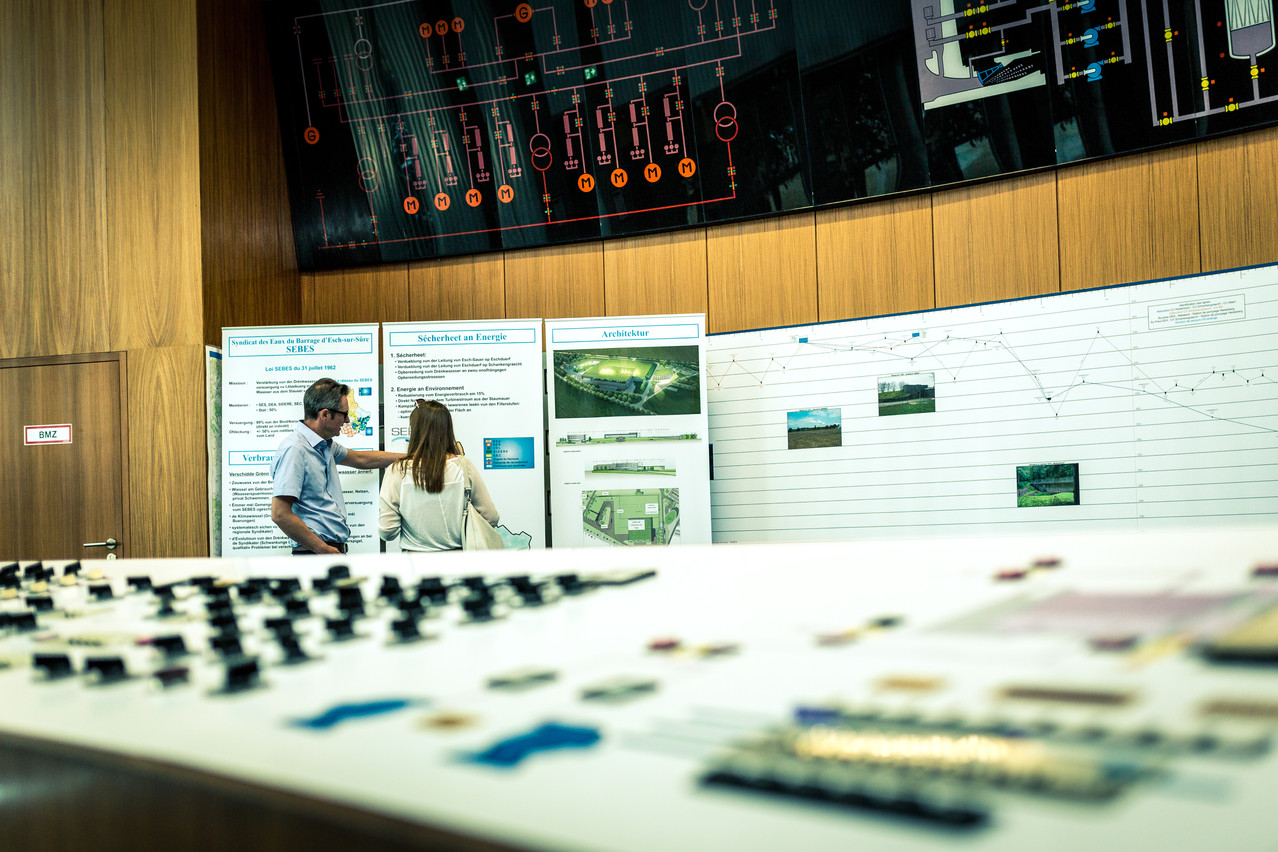60,000 cubic metres of water are consumed daily in Luxembourg; on hotter days that can go up to 82,000 cubic metres.
Some areas of the country, such as some parts of the West and the East are self-sufficient, because they have their own springs. But the whole of the North, Centre and South depend on this one facility: the dam near Esch-sur-Sûre and the water Sebes (which stands for Syndicate des Eaux du Barrage d’Esch-sur-Sûre, or Esch-sur-Sûre Dam Water Syndicate) collects in several reservoirs across the country.
The dam was built in the 1950s and filled for the first time in 1959; only a few houses were demolished to make space for the lake, which has a capacity of 60 million cubic metres. With a surface of 3.8 square kilometers, the dam is used for several purposes: naturally for drinking water, but also for electricity generation, flood control and increasingly for tourism and water sports.
Vintage control room
But back to the main element: water. The main water purification basins are housed in the 1960s Sebes building which was designed with particular flair. The entrance hall is steeped in green marble walls, and the grand staircase leading up the water purification basins is made of reddish-brown marble.
The impressive control system room, with its huge panels showing all the stages of purification and transportation, is something out of a James Bond film. It is kept to impress visitors, which it never fails to do, according to Kraus. However, the vintage panels, and the control panels with manual buttons and knobs, have long been replaced by computers.
The water is first filtered through flocculators, which is a system, based on natural procedures, that eliminates impurities.
Moving up the wide marble stairs, there is a visitor’s centre. It contains a vintage (1950s) wooden model of the whole Sûre valley. The model was made before the lake was actually filled. It shows the hilly landscape of the region and where houses stood in those days.
The lake sinews transparently through these hills, and underneath you can see the 10 or so houses which had to be appropriated by the state to make way for the reservoir. The centre has all sorts of interesting installations and panels which explain the water treatment, how consumption has changed, and how sustainable development, along with cooperation with farmers, is being promoted.
Huge basins contain sand and calcium carbonate
Closed to the public is the very cold and very grand hall. It contains the first yellow basins on the left, which filter the water with sand. After that, the water is pumped into the basins on the right, which are filled with calcium carbonate for deacidification purposes.
Sebes says that it only uses the minimum of chlorine necessary. This eliminates all viruses, medical residues, pesticides and organic matters. The water already looks squeaky clean in the blue basins, at least to Delano. The water sometimes has to be “hardened” because it’s too soft, says Kraus with a smile.
The water then goes down a few flights of stairs through several tubes, which are painted in several colours to show what stage the water is at. Here are the huge basins that hold filtered water.
In the next room, the surprisingly diminutive pumps then push the water up to the main reservoir in Eschdorf. The noise of just three out of the four pumps was deafening. One of these pumps can transfer 1.3 million litres per hour. From the reservoir in Eschdorf, the water can then be transferred to any one of the other reservoirs, whether in Dreibecken (South) or Schaedhaff or Contern (Centre). SEBES delivers water to all the country’s water companies: DEA; SES; SIDERE; SEC and Ville de Luxembourg.
However, Kraus said that this architectural mid-century marvel would be destroyed soon; the company needs to expand and the future maintenance costs for this building are simply too high--it was cheaper to build a new plant in Eschdorf, near the reservoir. The move is expected no earlier than 2020 though, so there is still time to explore it.
The dam
Outside again, it’s only a short walk to the dam itself. Signs on both sides indicate that it is drinking water, and should be respected as such. The sight is impressive, but the building does not seem massive. Indeed, while it is 47m high, its width is 4.5m, and on the narrowest part, it is only 1.5m.
A drive over it does not do it justice: it is better to walk over the dam to see how the lake spreads on one side and the empty space and plunging valley on the other. The water is already crystal clear--you can even make out the stones on the shore. The tranquil atmosphere is enhanced by the imposing wooded hills all around the dam.
Tourists sometimes stop at the nearby parking and want to have a peek. A drive up in the direction of Kaundorf offers a beautiful belvedere point which overlooks the dam and shows the Sebes building hidden amongst the trees above.
In nearby Lultzhausen, considerable money has been invested to make a moving footbridge over the lake. A youth hostel has been expanded and renovated. There is a nautical centre where boats can be rented.
You can only get to Esch-sur-Sûre through tunnels hewn in the slate stone hills on both ends. The village seems to have stopped in time in some parts. Several old tower ruins still guard jealously over the river, but the town has made itself pretty, with flower pots, cafés and ancient sinewy streets.
